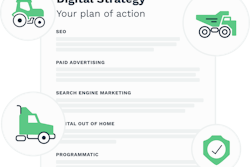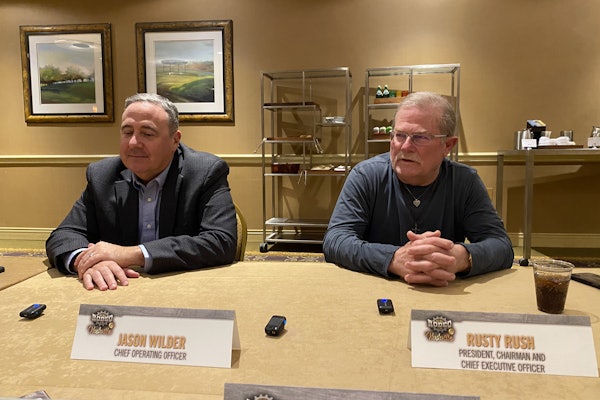By Bill Wade, Wade & Partners
Please take a couple of minutes to consider the distribution revolution underway:
Parts Suppliers Take a Hit from the Amazon Effect: E-commerce giants threaten both national parts distributors catering to big business and local shops. WSJ 8/20
Distributors reduce prices, ramp up e-commerce in response to Amazon: Distributors, including Grainger, have cut prices and fortified their e-commerce options to more effectively serve customers who have begun turning to Amazon for cheaper industrial supplies, particularly for spare parts and spot purchases. NAW SmartBrief 8/22
Customers “just want the Amazon buying experience at work,” says Prentis Wilson, vice president of Amazon Business, which was launched in 2015. He said many customers make one-time “spot” orders for parts, but Amazon is converting some larger businesses to manage their shopping on the marketplace. Fox News
Foot Locker shares slump 28 percent on weak sales: CEO blames suppliers for a dearth of ‘new products’ then adds: “The Amazon deal with Nike will not affect sales. We don’t believe our vendor selling direct on Amazon is an imminent threat.” WSJ 8/19
The greatest distributor in history wants you!
Amazon is trying to boost its catalog by telling tens of thousands of marketplace sellers in the U.S. that it will buy their inventory at full retail price.
In an email sent to sellers and obtained by CNBC, the Fulfillment by Amazon (FBA) team said that a new program is being rolled out where Amazon will buy products at full price from third-party merchants, then sell them to consumers across the globe.
“For a limited time, there will be no additional fees, and we will purchase inventory from you at your local marketplace offer price,” the email said.
The new program, which follows a similar rollout in Europe, is the latest move by Jeff Bezos to build up a complete catalog, even if Amazon can’t make much money on the products in question. In some cases, Amazon is approaching these third-party merchants after the manufacturer has declined to distribute the products through Amazon.
FBA is big and growing
With FBA, merchants pay a fee to have their inventory stored in Amazon’s fulfillment centers and to make use of the company’s supply chain and shipping operations. It’s a huge piece of Amazon’s e-commerce business.
In 2016, the number of FBA sellers worldwide grew more than 70 percent, and they delivered more than 2 billion items. Sounds profitable to resellers, good for customers and costly to Amazon. Or, smart!?
Big questions for distributors:
What longer-term beneficial returns does Amazon achieve by doing this? What threats and opportunities do Amazon’s covert benefits present to YOU (and all legacy channel players)?
Amazon gets multiple, high-leverage platform wins
According to distribution guru Bruce Merrifield “To understand Amazon’s total, long-term benefits from its ‘charitable’ announcement, you must understand how Amazon intersecting, reinforcing, platform assets work. Amazon increasing-returns platforms are:
- Prime Members
- Marketplace Resellers (total in-stock SKUs for both B2C and now B2B)
- FBA
- AMZ Web Services (AWS)
- The emerging Last-Mile Delivery and Alexa for Voice Commerce entries.”
(For more on these platforms, check out Bruce Merrifield’s excellent short blog at http://merrifieldact2.com/amazonsupply/partnering-with-amazon/)
Here are Amazon’s long-term gains:
- Distributors and other resellers make a profit and have more incentive to remain a cooperative reseller. It turns out that Walmart and other imitative marketplaces are trying to steal Amazon’s biggest, best resellers. Amazon needs even more business-to-business resellers to both crack the more difficult business-to-business channels and increase throughput in FBA, Prime-Now warehouses to get increasingly better last-mile metrics.
- Amazon must reverse the predator reputation they deserve from buying and selling their own stuff at steep discounts to win the critical-mass, Prime eyeballs and resellers, they now have. Amazon is feeling escalating heat from governments for being predators. New goal? Be the everyone-wins marketplace house that gets fees from all platform usage plus all buyer data.
- Amazon wants to keep and add to their Prime members. The more they get, the more sales volume grows, the more data is collected which enables more suggestive selling (35 percent of all sales). The more everyone goes to Amazon first for product search (55 percent and climbing) or eventually for more information (90 percent), no one goes to resellers’ web sites first or ever. Can resellers of physical products not be in Amazon’s marketplace?
- Amazon wants all brands to be in the marketplace (for second reason). If brands aren’t there or they are at higher prices, then the equally excellent clone products with great customer reviews gain market share.
Is this “The end of brands?”
No. If products are best total value, they will still have brand power. But, brands with an historic—emotional, irrational premium price and profitability—will see their profits pressured from the customer-generated informational content and reviews. This is also true for rep/distributor relationships that no longer offer real value. The doughnut patrol is over.
All of these increased activities consume more Amazon Web Services (AWS) for both internal and external customers. Resellers (using AWS partners) are subscribing to all of Amazon’s home grown tools and cloud capacity, especially reseller-site, support services including:
- Database analysis of existing products in the Marketplace;
- Dynamic pricing;
- (New) working capital loans.
Threats and opportunities for distributors
The threats are big. Amazon has built the end-customer, back-to-factories, all-digital, value-chain. For experienced (low cost to serve) customers who want to re-buy commodities, Amazon is better in every way. Some certain results:
- Less-effective, legacy channel players will lose so much in sales and profits that they will fail or have to rethink their hidebound, service-cost models.
- Outside and inside sales reps will eventually have to be unbundled, and their “service values” sold perhaps on an unbundled-for- fees basis.
- Not all types of sales are immediately vulnerable. High-cost, low-sales customers and losing items will stay; custom-service-input sales will remain for the time being.
However, Amazon is the world’s most inventive logistics company with unbound ambition for selling physical goods. They are, for example, currently building four warehouses for “bulky” item sales (initially furniture and appliances). New business models will have to be as good or better value than what Amazon is offering. Bolt-on web sites that sell all visitors what you have in your stock will fizzle.
What are the opportunities?
For distributors taking the ‘fine, but they’re not in the vehicle parts business’ reality dodge, slim and fading. Amazon has created a better value-chain underpinned by winner-take-all platform links.
- You can join AMZ-BIZ as a niche-focused reseller;
- You can look to join potentially emerging, vertical marketplaces that are more focused on historic channel end-users than AMZ-BIZ;
- You can pursue partnership replenishment systems with the biggest, best customers in your portfolio.
However, this will require some non-traditional action steps;
- Stop losing money on 60 to 80 percent of your active accounts. This may seem like an unrealistic percentage of loser accounts, but our WayPoint-based research (on over 100 industrial distributors) shows it to be correct.
- Redeploy total team efforts to: giving best customers (niche-tuned) perfect service guaranteed. Identifying and reducing the existing, but unnecessary small-dollar (and often emergency/downtime) picks, orders and credits is the counter-intuitive secret.
- Use your documented savings and services to ask for a 100 percent spend-share, open-book, continuously improving, evergreen replenishment system.
Warning: Only about 25 percent of your big accounts have the vision and capability to be good, long-term partners. Pick, pitch and manage them well.
Finally, custom ‘webulize’ the relationship into your firm. Become a technology business that happens to sell vehicle parts expertly. These contracts will still have to accommodate bottom-up, spot buys from AMZ-BIZ unless you can find ways to be as service friendly.
Amazon Business is growing at 20 percent per month. Just saying.
For a great statistical look at AMZ: https://www.inddist.com/e-commerce/blog/13774582/amazon-by-the-numbers
Bill Wade is a partner at Wade & Partners and a heavy-duty aftermarket veteran. He is the author of Aftermarket Innovations. He can be reached at [email protected].











